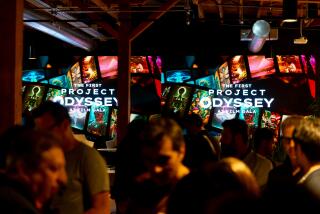The Museum of Technological Innovations and Yawns
- Share via
SAN JOSE — The two siblings try to elbow one another out of the way as they lunge for the controls of the computer on the second-floor landing of the Tech Museum of Innovation. There are whispers and giggles as they begin to design a virtual robot on the large color screen. But after no more than 30 seconds there’s only silence.
The children are bored.
“I thought they would have newer computers,” complains Nuri Hidalgo, 14. “What I wanted was real robots for us to control,” says her 12-year-old brother, Josue, with a sigh.
When “The Tech”--a 132,000-square-foot, mango-and-electric blue architectural monument to Silicon Valley innovation--opened its doors nearly three years ago, it mocked the idea of museums as timeless interpreters of history. It was, as early board member Regis McKenna put it, more about tomorrow than yesterday.
But as technology has surged, the museum has had trouble keeping up.
A handful of the 240 or so exhibits always seems to be broken. Others use technology that has become outdated. Given the speed of innovation lately and more people having access to computers at home or school, science and technology museums across the nation are struggling with how to remain relevant.
“By the time you’ve made the exhibits, the subject is no longer of much interest, or maybe things have changed radically,” said David W. Ellis, president of the Museum of Science in Boston. “This is a problem in the computer world more than any other.”
The Tech’s digital studio, for instance--which lets people create their own mini-movies--might seem primitive to those who have tried Apple Computer’s jazzy new iMovie tool, which comes preinstalled on its machines. The umbrella-covered terminals where visitors can chat with one another online might seem ordinary in a world where people have already begun to zap instant messages on cell phones and pagers.
Visitors to another display are greeted by the message: “Online and wireless connections give us new ways to meet people, keep in touch and work or play together.” That sounds like an America Online commercial--from five years ago.
Even the seemingly cool machine that lets people scan their heads into a 3-D image began to look dated after a London company came out with a product that lets people scan in their whole bodies and move the image around on a computer screen.
Taesang Uhm, a 36-year-old technical consultant from Seoul, Korea, who was visiting the Tech with friends recently, could find hardly anything that interested him. He left after wandering around for an hour or so. “This is Silicon Valley,” he said with a frown. “I expected more advanced, leading technology.”
It turns out technology is an issue even for exhibits that aren’t specifically about technology. Abbie Chessler, a Laurel, Md., museum display consultant, remembers having to overhaul her designs for the Experience Music Project--former Microsoft Corp. executive Paul Allen’s state-of-the-art rock ‘n’ roll museum in Seattle--more than a few times to integrate new sound and display inventions. About 10 months before she started construction, Chessler says she finally gave up and decided to lock in the hardware and software.
“Of course you want the absolute latest and best, but there does come a point when you have to draw the line,” Chessler said.
Ellis, the president of the Boston museum, says it typically takes 18 months or more to create a permanent display--an eternity in a world where small electronic breakthroughs seem to happen every day.
His museum’s way of coping has been to create a separate wing--the “Current Science & Technology Center”--which features exhibits and presentations that rotate every few months. The space, which opened in the spring, features a robot dinosaur, a robot tuna and other robots on loan from the Massachusetts Institute of Technology, Northeastern University and other schools.
Rachel Hellenga, director of exhibits for the Tech, says the museum sets aside $500,000 to $1 million a year to upgrade about 10% of the floor space. The museum already anticipates having to re-create its Internet and genetics sections because so much has changed since they were erected almost three years ago.
The Tech also has set aside space for rotating exhibits and demonstrations and offers four “curiosity counters” where staff members or volunteers show off the latest electronic gizmos. They sometimes feature prototypes of products not yet on the market, such as a child’s wristwatch with a global positioning system that can pinpoint the wearer’s location. But most of the time they are the same things one might find at a Sharper Image or in an online computer catalog.
More to Read
The biggest entertainment stories
Get our big stories about Hollywood, film, television, music, arts, culture and more right in your inbox as soon as they publish.
You may occasionally receive promotional content from the Los Angeles Times.










